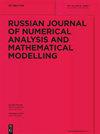变分同化问题中响应函数对系统输入灵敏度的数值计算
IF 0.6
4区 数学
Q4 MATHEMATICS, APPLIED
Russian Journal of Numerical Analysis and Mathematical Modelling
Pub Date : 2022-02-01
DOI:10.1515/rnam-2022-0004
引用次数: 2
摘要
摘要水流污染预测是一项非常重要的任务。为此,必须能够定义模型预测中的不确定性。这是敏感性分析的目的,其作用是确定模型输出中的不确定性归因于模型输入(在这种情况下为参数)。传统上,这是通过在参数空间中运行被许多随机样本扰动的模型来实现的,以确定它们对模型输出的影响。它提供了关于输出方差的多少由输入的每个参数控制的信息。本文给出了与基于过程的伴随方法相关的理论结果,该方法用于计算响应函数(RF)对输入源变化的灵敏度。结果表明,这种方法允许通过在给定时间间隔内对伴随方程进行一次积分来计算RF对位于感兴趣域中的任何源的灵敏度。将所提出的方法应用于二维圣维南流动方程,以模拟水污染问题。为了研究某些RF对观测的敏感性,制定并实施了河内Thanh Nhan湖的数值实验。该数值模型是采用众所周知的有限体积法建立的。介绍了两个合适的优化问题,并在BFGS算法的基础上进行了求解。数值结果表明了该方法的有效性,并证实了理论结果。本文章由计算机程序翻译,如有差异,请以英文原文为准。
On numerical computation of sensitivity of response functions to system inputs in variational data assimilation problems
Abstract Prediction of pollution in water flow is a very important task. To this end, it is imperative to be able to define the uncertainty in a model prediction. This is the purpose of sensitivity analysis whose role is to identify what uncertainty in the model outputs is attributable to the model inputs (parameters in this case). Traditionally, this is achieved by running the model perturbed by many random samples in the parameter space to determine their impact on the model outputs. It provides information on how much of the output variance is controlled by each parameter of the inputs. The theoretical results related to the procedure based adjoint approach for computing a sensitivity of the response function (RF) to changes in the input source are presented in the paper. It is shown that this approach allows to compute, by one single integration of the adjoint equation over a given time interval, a sensitivity of the RF to any source located in the domain of interest. The proposed approach is applied to the 2D Saint-Venant flow equations for modelling the water pollution problem. A numerical experiment is formulated and implemented for the Thanh Nhan Lake in Hanoi for studying a sensitivity of some RF to observations. The numerical model is constructed by applying the well-known finite-volume method. Two appropriate optimization problems are introduced and solved on the basis of the BFGS algorithm. The numerical results show the efficiency of the proposed method and confirm the theoretical findings.
求助全文
通过发布文献求助,成功后即可免费获取论文全文。
去求助
来源期刊
CiteScore
1.40
自引率
16.70%
发文量
31
审稿时长
>12 weeks
期刊介绍:
The Russian Journal of Numerical Analysis and Mathematical Modelling, published bimonthly, provides English translations of selected new original Russian papers on the theoretical aspects of numerical analysis and the application of mathematical methods to simulation and modelling. The editorial board, consisting of the most prominent Russian scientists in numerical analysis and mathematical modelling, selects papers on the basis of their high scientific standard, innovative approach and topical interest.
Topics:
-numerical analysis-
numerical linear algebra-
finite element methods for PDEs-
iterative methods-
Monte-Carlo methods-
mathematical modelling and numerical simulation in geophysical hydrodynamics, immunology and medicine, fluid mechanics and electrodynamics, geosciences.

 求助内容:
求助内容: 应助结果提醒方式:
应助结果提醒方式:


